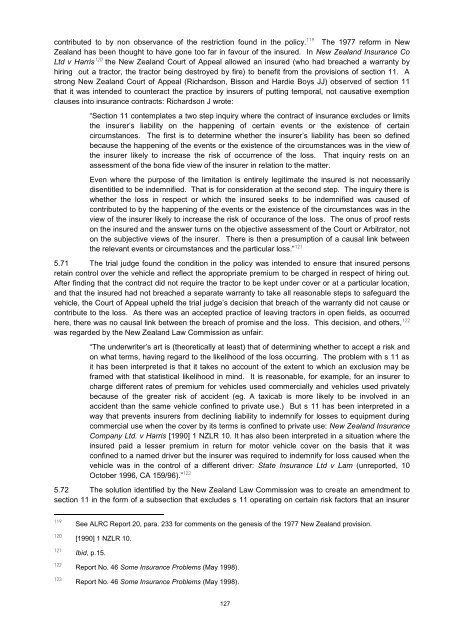Insurance Contracts CP - Law Reform Commission
Insurance Contracts CP - Law Reform Commission
Insurance Contracts CP - Law Reform Commission
You also want an ePaper? Increase the reach of your titles
YUMPU automatically turns print PDFs into web optimized ePapers that Google loves.
contributed to by non observance of the restriction found in the policy. 119 The 1977 reform in New<br />
Zealand has been thought to have gone too far in favour of the insured. In New Zealand <strong>Insurance</strong> Co<br />
Ltd v Harris 120 the New Zealand Court of Appeal allowed an insured (who had breached a warranty by<br />
hiring out a tractor, the tractor being destroyed by fire) to benefit from the provisions of section 11. A<br />
strong New Zealand Court of Appeal (Richardson, Bisson and Hardie Boys JJ) observed of section 11<br />
that it was intended to counteract the practice by insurers of putting temporal, not causative exemption<br />
clauses into insurance contracts: Richardson J wrote:<br />
―Section 11 contemplates a two step inquiry where the contract of insurance excludes or limits<br />
the insurer‘s liability on the happening of certain events or the existence of certain<br />
circumstances. The first is to determine whether the insurer‘s liability has been so defined<br />
because the happening of the events or the existence of the circumstances was in the view of<br />
the insurer likely to increase the risk of occurrence of the loss. That inquiry rests on an<br />
assessment of the bona fide view of the insurer in relation to the matter.<br />
Even where the purpose of the limitation is entirely legitimate the insured is not necessarily<br />
disentitled to be indemnified. That is for consideration at the second step. The inquiry there is<br />
whether the loss in respect or which the insured seeks to be indemnified was caused of<br />
contributed to by the happening of the events or the existence of the circumstances was in the<br />
view of the insurer likely to increase the risk of occurance of the loss. The onus of proof rests<br />
on the insured and the answer turns on the objective assessment of the Court or Arbitrator, not<br />
on the subjective views of the insurer. There is then a presumption of a causal link between<br />
the relevant events or circumstances and the particular loss.‖ 121<br />
5.71 The trial judge found the condition in the policy was intended to ensure that insured persons<br />
retain control over the vehicle and reflect the appropriate premium to be charged in respect of hiring out.<br />
After finding that the contract did not require the tractor to be kept under cover or at a particular location,<br />
and that the insured had not breached a separate warranty to take all reasonable steps to safeguard the<br />
vehicle, the Court of Appeal upheld the trial judge‘s decision that breach of the warranty did not cause or<br />
contribute to the loss. As there was an accepted practice of leaving tractors in open fields, as occurred<br />
here, there was no causal link between the breach of promise and the loss. This decision, and others, 122<br />
was regarded by the New Zealand <strong>Law</strong> <strong>Commission</strong> as unfair:<br />
―The underwriter‘s art is (theoretically at least) that of determining whether to accept a risk and<br />
on what terms, having regard to the likelihood of the loss occurring. The problem with s 11 as<br />
it has been interpreted is that it takes no account of the extent to which an exclusion may be<br />
framed with that statistical likelihood in mind. It is reasonable, for example, for an insurer to<br />
charge different rates of premium for vehicles used commercially and vehicles used privately<br />
because of the greater risk of accident (eg. A taxicab is more likely to be involved in an<br />
accident than the same vehicle confined to private use.) But s 11 has been interpreted in a<br />
way that prevents insurers from declining liability to indemnify for losses to equipment during<br />
commercial use when the cover by its terms is confined to private use: New Zealand <strong>Insurance</strong><br />
Company Ltd. v Harris [1990] 1 NZLR 10. It has also been interpreted in a situation where the<br />
insured paid a lesser premium in return for motor vehicle cover on the basis that it was<br />
confined to a named driver but the insurer was required to indemnify for loss caused when the<br />
vehicle was in the control of a different driver: State <strong>Insurance</strong> Ltd v Lam (unreported, 10<br />
October 1996, CA 159/96).‖ 123<br />
5.72 The solution identified by the New Zealand <strong>Law</strong> <strong>Commission</strong> was to create an amendment to<br />
section 11 in the form of a subsection that excludes s 11 operating on certain risk factors that an insurer<br />
119<br />
120<br />
121<br />
122<br />
123<br />
See ALRC Report 20, para. 233 for comments on the genesis of the 1977 New Zealand provision.<br />
[1990] 1 NZLR 10.<br />
Ibid, p.15.<br />
Report No. 46 Some <strong>Insurance</strong> Problems (May 1998).<br />
Report No. 46 Some <strong>Insurance</strong> Problems (May 1998).<br />
127

















